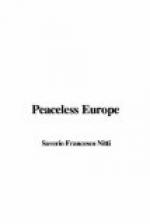Although it is a matter of recent history, we may as well call to mind that the Entente Powers have always maintained that the War was wanted and was imposed by Germany; that she alone, with her Allies, repeatedly violated the rights of peoples; that the World War could well be regarded as the last war, inasmuch as the triumph of the Entente meant the triumph of democracy and a more human regime of life, a society of nations rich in effects conducive to a lasting peace. It was imperative to restore the principles of international justice. In France, in England, in Italy, and later, even more solemnly, in the United States, the same principles have been proclaimed by Heads of States, by Parliaments and Governments.
There are two documents laying down and fixing the principles which the Entente Powers, on the eve of that event of decisive importance, the entry of the United States into the War, bound themselves to sustain and to carry on to triumph. The first is a statement by Briand to the United States Ambassador, in the name of all the other Allies, dated December 30, 1916. Briand speaks in the name of all “les gouvernements allies unis pour la defense et la liberte des peuples.”
Briand’s second declaration, dated January 10, 1917, is even more fundamentally important. It is a collective note of reply to President Wilson, delivered in the name of all the Allies to the United States Ambassador. The principles therein established are very clearly enunciated. According to that document the Entente has no idea of conquest and proposes mainly to achieve the following objects:
1st. Restoration of Belgium, Serbia and Montenegro, with the indemnities due to them.
2nd. Evacuation of invaded territories in France, Russia and Rumania and payment of just reparations.
3rd. Reorganization of Europe with a permanent regime based on the respect of nationalities and on the right of all countries, both great and small, to complete security and freedom of economic development, besides territorial conventions and international regulations capable of guaranteeing land and sea frontiers from unjustified attacks.
4th. Restitution of the provinces and territories taken in the past from the Allies by force and against the wish of the inhabitants.
5th. Liberation of Italians, Slavs, Rumanians and Czeko-Slovaks from foreign rule.
6th. Liberation of the peoples subjected to the tyranny of the Turks and expulsion from Europe of the Ottoman Empire, as being decidedly extraneous to western civilization.
7th. The intentions of his Majesty the Emperor of Russia in regard to Poland are clearly indicated in the proclamation addressed to his armies.
8th. The Allies have never harboured the design of exterminating German peoples nor of bringing about their political disappearance.




